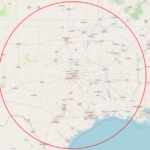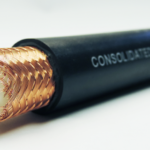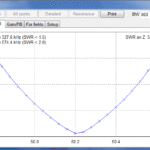By Chip Coker KD4C
At Field Day 2019, RWK had a side activity where hams built a small “tape-measure yagi” and had a small foxhunt in Lookout park. Since shortly after Field Day 2019, we have staged foxhunts in the City of Richardson most every weekend with at least one fox (and two foxes on most weekends). While foxhunting has been a fun and active for the klub, it has a practical purpose. Foxhunters develop the skills required to identify and locate harmful and malicious interference to amateur and public service. And last week those skills were needed.
On Wednesday, April 20th, the RWK was called into service to help find the source of a signal that had timed out the 146.92 main Denton County DCARA repeater since the previous evening. Seems that a “stuck PTT” or dead-air carrier (with no modulation) had appeared on the input to the 146.92 repeater the previous evening, effectively timing out the repeater. They (DCARA) hoped that it would be discovered by the owner and resolved overnight (someone would have figured out that their mic was stuck on or wedged between the seat, etc.). When that didn’t happen by Weds. morning, more drastic measures were called for.
You see, DCARA really needed their repeater to be available on Weds. afternoon. They were assisting in a Annual Medal of Honor Motorcade Escort Public Service Event (escorting Medal of Honor recipients from DFW airport to Gainesville TX), and that repeater was planned to be the center of communications for the event. Having a down 92 repeater would have required a complete replanning of the event just 3 hours before it started.
So early Weds., they started to track down the offending signal.
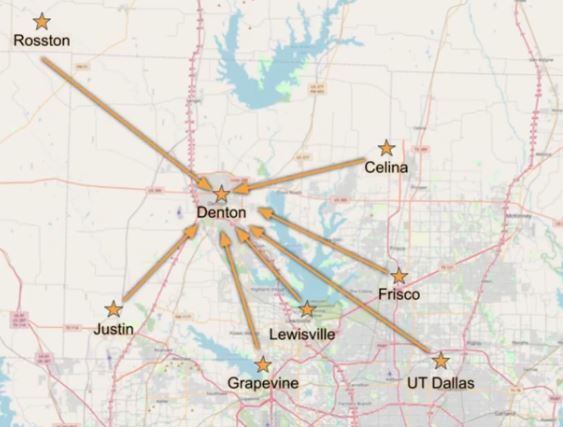
The DCARA 92 repeater has a “voter” configuration to cover all of Denton county. In addition to the main repeater site on the TWU campus, there are an additional seven receivers spread around the county. Those receivers “vote” to determine who has the best received signal, and that signal is the one that is “repeated”. From comparing the signals received by the voter receivers, DCARA knew that the offending transmitter was pretty far south in Denton county and that the transmitter was pushing out some high power (the voter on the Lewisville Dam was almost full strength and the signal was being received at both the main repeater site and the voter on the 1500′ Rosston tower site covering NE Denton county).
Announcements were put out for both DCARA and RWK members to assist in finding the offending transmitter. Anyone that could hear the transmitter on the repeater input (146.32) was encouraged to report S-meter and antenna height (and heading if they had a directional antenna). From the several reports received in the next few minutes (including 6 or 7 reports from RWK and a near full-strength reading from our own Josh N4NZ in Farmers Branch), we had an initial target location: I-35 and the President Bush tollway.
Unfortunately, our chief foxhunter, Bob KG5WRY, was out of town (he could have had this wrapped up in a matter of a few minutes with his fancy setup!). So we had to resort to standard foxhunting techniques. I picked up Andrew KE5GDB at his casa and we headed west on the Bush tollway, with me driving (and fighting with my overdrive) and Andrew running the radio, watching the voter signals and looking at the map and signal reports from the members.
When we got to the projected I-35 and tollway intersection and the S-meter was not yet full strength on my roof-mounted antenna, we knew that it was further west and kept going. At the tollway intersection with I-635, it was S-8, so we headed west on I-635 towards the north entrance to DFW Airport. At just west of the Freeport Pkwy. exit, we had a full S-meter and dialed the VFO to 146.31 (10kHz down from the main freq). When you go “off frequency” you receive less of the transmitted signal due to the shape of the FM deviation curve, so we got back several units of S-meter to aid in the search. My truck radio is also capable of dual-VFO dual-receive operation, so we tuned the second VFO to the third harmonic of 146.32 to listen for the third harmonic of the transmitter (no radio is perfect and every radio will transmit a small amount of energy on the third – and even fifth – harmonics of the main frequency, and we can use those to help in locating the transmitter).
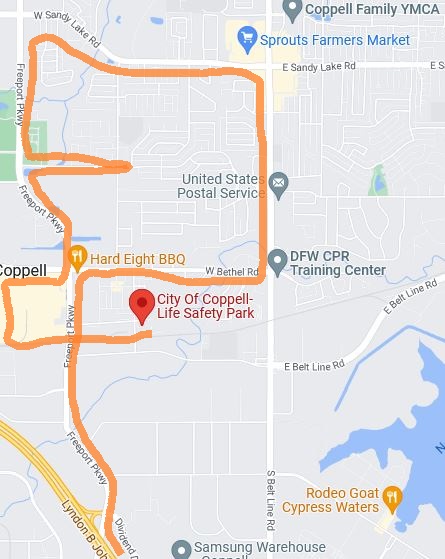
We headed north on Freeport Pkwy. into a warehouse and office park district. We had previously speculated what kind of transmitter might be the source? We had ruled out anything hand-held due to the power output and the fact that it had not run down in over 12 hours. That left a mobile radio or a base unit with lots of AC or battery power. We also briefly considered a cross-band repeat mobile radio that had something on the crossband input frequency (so be extra careful if you set up something like that for your backyard!). We were convinced that it would be located in a residential area (moral: always trust your data more than your intuition).
Just south of the intersection of Bethel Rd, we heard a 1/2 second burst on the third harmonic receiver, which of course got us excited because we should have been close. We then turned right onto Bethel, towards the closest residential area. The area in front of us was somewhat hilly, so our S-meter readings were fluctuating, but overall the signal was not increasing and nothing further on the third harmonic, so we turned north onto Denton Tap. Still more hills and nothing stronger and no third! Trust your data! We headed west on Sandy Lake and then back south on Freeport to see if we could bound the area. That section of Freeport wasn’t hilly and the signal was increasing, so south was the right direction! So we turned left into the residential area, again thinking it was going to be at a house. Trust your data! When the signal got weaker, we doubled back out of the neighborhood and headed south again on Freeport. At the Coppell town square, we had full S-meter on the 10kHz off receiver and again barks of squelch on the third harmonic. From there, it was a simple matter to peak the S-meter of the third harmonic receiver. We slowly drove another block west (crossing the same street we had been on 10 minutes earlier) and just in front of us was the City of Coppell Fire Station #1 and Emergency Operations Center (EOC), and Andrew said “Oh, I’ve seen this before…” which is usually never good to hear coming out of his mouth.
We briefly surveyed the parking lot and then convinced ourselves that it was coming from “inside the house” (inside the Fire Station building), so we parked and basically rang the doorbell. A very nice man in a uniform answered and Andrew proceeded to explain the situation and asked “can we see your radios?” Luckily, a) the guy that answered the door (Kevin) was part of the EOC staff (not a fireman), and b) he understood what we were saying. He took us in to the Coppell EOC (which he did not have to do) and showed us their radio setup (which he definitely did not have to do).
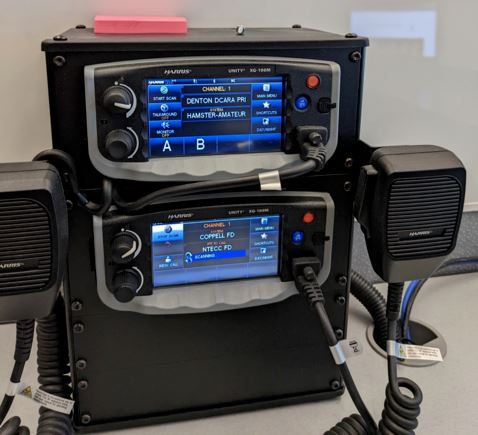
In the EOC’s “weather” cubicle, there were two Harris Unity XG-100M commercial public service radios ($7,000 each!), and the top radio was tuned to “Denton DCARA primary”. Bingo! Coppell EOC regularly monitors the SKYWARN nets on the DCARA repeater. Interestingly enough, there was no indication on the control panel that the radio was transmitting, but a power cycle of the radio seemed to fix whatever was wrong. After a quick check with HTs and waiting for the DCARA repeater to reset from the timeout (and saying hello to Heath KC5TSU, another DCARA member that had just pulled up), the repeater was back up and working. Andrew even had a short QSO over the repeater using the offending Coppell EOC radio. Problem solved, and just in time for the Medal of Honor event.
I picked Andrew up at 9:50am and we were at the Coppell EOC by around 10:45am – a bit less than an hour for the physical hunt, including travel time.
Takeaways from the day: 1) you never know when you’re going to need those foxhunting skills, but it’s good to have them when needed! 2) Trust your data over your intuition – we could have saved some time if we were not “convinced” that it was going to be at a residential address. 3) Teamwork and every little bit of information helps – The initial signal reports narrowed the location down from an entire county (and beyond) to just a small area. 4) The techniques that you use for casual weekend foxhunting are the same that you use for real – and they work.

